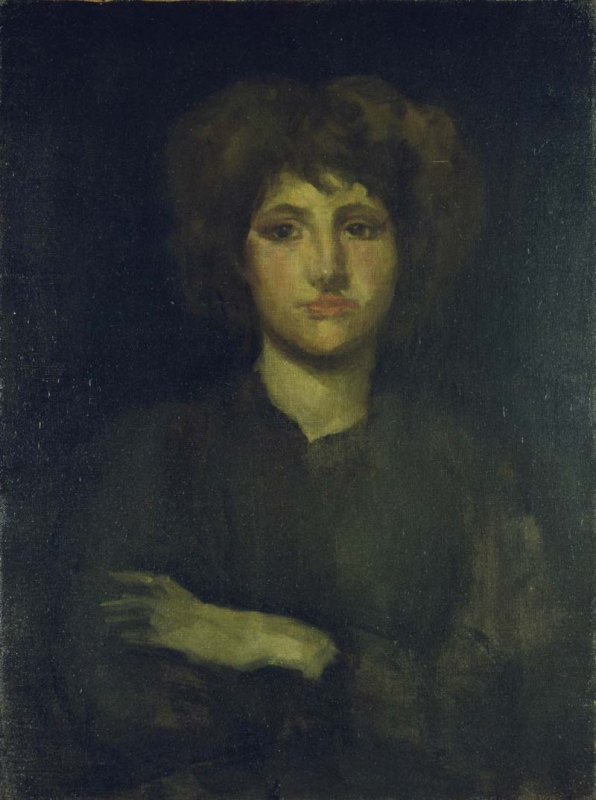Home > Catalogue > Browse > Portrait Study of Lily Pettigrew << >>
Technique
It is on a fine weave closely-woven canvas. Although it was undoubtedly painted in London, the canvas was perhaps acquired in Paris, since it appears to be a 'toile de 12' (61 x 46 cm). It was painted freely with thinned paint in broad brush strokes.
The painting was examined in February 2020, when a full technical examination was carried out in the School of Culture and Creative Arts Technical Art History laboratory in the Hunterian at Kelvin Hall. Professors Joyce H. Townsend and Margaret F. MacDonald examined the painting under a microscope. A high resolution camera for infra-red reflectography (IRR) was operated by Tess Visser, a PhD student supervised by Professor Christina Young, assisted by Alicia Hughes, Hunterian curatorial assistant. Images were also made of the verso, and of the recto in normal, raking, and ultraviolet light.
The canvas is uniformly thinly painted, thinner than the width of the canvas threads and following their contours. It was rubbed or wiped down in several areas, particularly the face.
Both the lips and the highlight on the nose (the thickest paint of the face) have been rubbed down to reveal a lower layer of paint, but the rubbing does not go down as far as the top of the canvas threads. It reveals a greyer layer that is a very thin light grey priming. In the bodice the rubbing-down reaches the top of the canvas threads, again revealing the light grey priming. There are many cracks following the line of the threads: this suggests the rubbing was done to dry paint, not wet, and this caused the cracking. The composition was thus built up over several sessions, not painted all at once, au premier coup.
The rubbing down may have been done with very fine sandpaper or a pumice stone, rather than a cloth. 1 Whistler had incorporated such rubbing down in his studio practise for years. In a letter to his wife in 1892, regarding the portrait Arrangement in Black and Gold: Comte Robert de Montesquiou-Fezensac [YMSM 398], he wrote:
'I was determined to go through with the whole picture in one perfect final coating - for which I had been enabled to prepare the canvass with one last scraping, and pommice [sic] stoning and washing and the terrible bag of tricks that we know only too well!' 2
In the portrait of Lily Pettigrew, there is no evidence of under-drawing. The costume appears to be not fully resolved at the neck and right cuff. It has full sleeves, possibly in a lighter or more sheer fabric. Her waist is just barely defined. Her hair originally extended further out. The fingers of the left hand (the flesh paint including large particles of bone black) were very lightly brushed in. Even after this reworking, the costume remained unresolved at the neck and at the cuff of the left hand. The sitter’s right hand is plausibly not visible, since her arms are folded and the full sleeve conceals it.
The infrared reflectogram shows more clearly than the painting itself that her arms are folded and the hands therefore at the same height, whilst suggesting that the sleeves may have a different fabric from the small-waisted bodice.
It is clear that bone black has been extensively used in the paint, both in the dark areas and flesh colours. In the flesh paint, there is also a deep pink organic pigment that may be madder. It is in the red lips, too, but the darker red between the lips is a different, bluer deep pink organic pigment. The shadows of the nose have a larger amount of bone black.
There are two pink layers of thin paint in the face. In the white of the eye there is a slight degree of mixing in of blue pigment, possibly Prussian blue. Light paint was applied to build up her features as highlights, working from dark to light.
Some minor reworking was done after the painting was first varnished – though Whistler might have regarded this as a ‘retouching varnish’ that enabled him to see more clearly which areas required more work. This included an area under her right ear, some adjustment of the neckline, and fine horizontal lines outlining her eyes, accentuating her exotic looks. There may also have been a final brushstroke of a little madder for the lips.
The painting was finally revarnished with a varnish of natural resin type.
Conservation History
The canvas has been neatly trimmed, then lined to another canvas. The stretcher might have been reused since the canvas dimensions are visibly unchanged, but might equally be a replacement. A thick varnish of natural resin type was applied at this time or later, since it runs onto the lining canvas. This could have occurred in Whistler’s lifetime, though given the late date of the work it was more likely a posthumous treatment.
Notes:
1: Whistler mentioned, apropos of Brown and Gold: Portrait of Lady Eden [YMSM 408] 'I have been sand papering it down all the afternoon', letter to R. Birnie Philip, [30 October 1899], FUW #04755.
2: Whistler to Beatrice Whistler, [24 January 1892], GUW #06606.
Last updated: 8th April 2021 by Margaret










